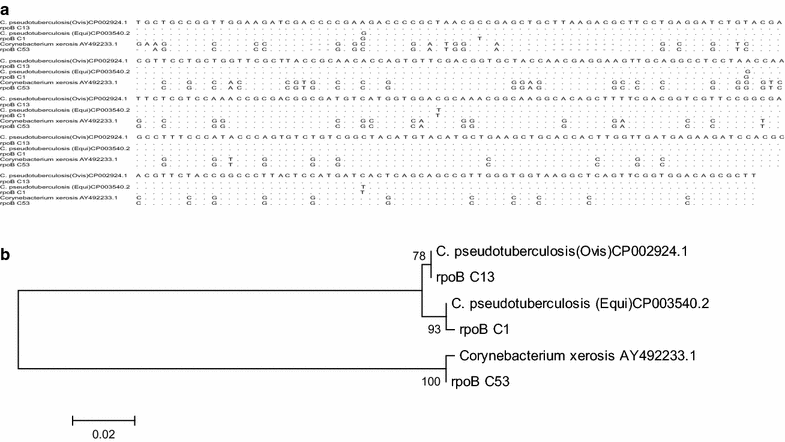Identification and molecular characterization of Corynebacterium xerosis isolated from a sheep cutaneous abscess: first case report in Mexico
- PMID: 27448802
- PMCID: PMC4957927
- DOI: 10.1186/s13104-016-2170-8
Identification and molecular characterization of Corynebacterium xerosis isolated from a sheep cutaneous abscess: first case report in Mexico
Abstract
Background: Corynebacterium xerosis is a commensal organism found in skin and mucous membranes of humans. It is considered an unusual pathogen, and it is rarely found in human and animal clinical samples. Here we describe the isolation of C. xerosis from a 4-months-old Pelifolk lamb located in Tesistán, central western Mexico. This microorganism should be considered for differential diagnosis in cutaneous abscessed lesions in sheep, as it represents a zoonotic risk factor for human infection in sheep farms.
Case presentation: The animal exhibited a hard-consistency, 5 cm diameter abscess, without drainage, in the neck. The presumptive clinical diagnosis was caseous lymphadenitis, caused by Corynebacterium pseudotuberculosis. Samples were obtained by puncture and cultured in 8 % sheep blood agar under microaerophilic conditions. Colonies were non-haemolytic, brown-yellowish and showed microscopic and biochemical features similar to C. pseudotuberculosis, except for the urea test. A multiplex-PCR for the amplification of partial sequences of the pld, rpoB and intergenic fragment from 16S to 23S genes suggested that isolate could be C. xerosis, which was later confirmed by sequencing analysis of the rpoB gene.
Conclusions: This study shows for the first time isolation and molecular characterization of C. xerosis from a clinical sample of an ovine cutaneous abscess in Mexico. This finding highlights the need for differential diagnosis of this pathogen in ovine skin abscesses, as well as epidemiological and control studies of this pathogen in sheep farms.
Keywords: Case report; Corynebacterium pseudotuberculosis; Corynebacterium xerosis; Pld gene; RpoB gene; Sheep; Skin abscess.
Figures




Similar articles
-
Isolation and molecular characterization of Corynebacterium pseudotuberculosis from sheep and goats in Mexico.Microb Pathog. 2018 Apr;117:304-309. doi: 10.1016/j.micpath.2018.02.031. Epub 2018 Feb 20. Microb Pathog. 2018. PMID: 29474828
-
Bacteriological, cytological, and molecular investigation of Corynebacterium pseudotuberculosis, mycobacteria, and other bacteria in caseous lymphadenitis and healthy lymph nodes of slaughtered sheep.Braz J Microbiol. 2021 Mar;52(1):431-438. doi: 10.1007/s42770-020-00403-0. Epub 2020 Nov 13. Braz J Microbiol. 2021. PMID: 33185852 Free PMC article.
-
Double-antibody sandwich enzyme-linked immunosorbent assay and immunoblot analysis used for control of caseous lymphadenitis in goats and sheep.Am J Vet Res. 1992 Jul;53(7):1125-32. Am J Vet Res. 1992. PMID: 1497180
-
Corynebacterium pseudotuberculosis and its role in ovine caseous lymphadenitis.J Comp Pathol. 2007 Nov;137(4):179-210. doi: 10.1016/j.jcpa.2007.07.002. Epub 2007 Sep 10. J Comp Pathol. 2007. PMID: 17826790 Review.
-
Caseous lymphadenitis in small ruminants.Vet Clin North Am Food Anim Pract. 2001 Jul;17(2):359-71, vii. doi: 10.1016/s0749-0720(15)30033-5. Vet Clin North Am Food Anim Pract. 2001. PMID: 11515406 Review.
Cited by
-
Current levels of microplastic pollution impact wild seabird gut microbiomes.Nat Ecol Evol. 2023 May;7(5):698-706. doi: 10.1038/s41559-023-02013-z. Epub 2023 Mar 27. Nat Ecol Evol. 2023. PMID: 36973353 Free PMC article.
-
Insight into the intestinal microbiome of farrowing sows following the administration of garlic (Allium sativum) extract and probiotic bacteria cultures under farming conditions.BMC Vet Res. 2020 Nov 13;16(1):442. doi: 10.1186/s12917-020-02659-y. BMC Vet Res. 2020. PMID: 33187511 Free PMC article.
-
Whole-Genome Sequence of Corynebacterium xerosis Strain GS1, Isolated from Yak in Gansu Province, China.Microbiol Resour Announc. 2019 Sep 12;8(37):e00556-19. doi: 10.1128/MRA.00556-19. Microbiol Resour Announc. 2019. PMID: 31515333 Free PMC article.
-
Preliminary In Vitro Evaluation of Silver, Copper and Gold Nanoparticles as New Antimicrobials for Pathogens That Induce Bovine Locomotion Disorders.Int J Mol Sci. 2024 Aug 31;25(17):9494. doi: 10.3390/ijms25179494. Int J Mol Sci. 2024. PMID: 39273440 Free PMC article.
-
Bacterial association observations in Lucilia sericata and Lucilia cuprina organs through 16S rRNA gene sequencing.Appl Microbiol Biotechnol. 2021 Feb;105(3):1091-1106. doi: 10.1007/s00253-020-11026-8. Epub 2021 Jan 7. Appl Microbiol Biotechnol. 2021. PMID: 33415370
References
Publication types
MeSH terms
Substances
LinkOut - more resources
Full Text Sources
Other Literature Sources
Medical
Molecular Biology Databases

